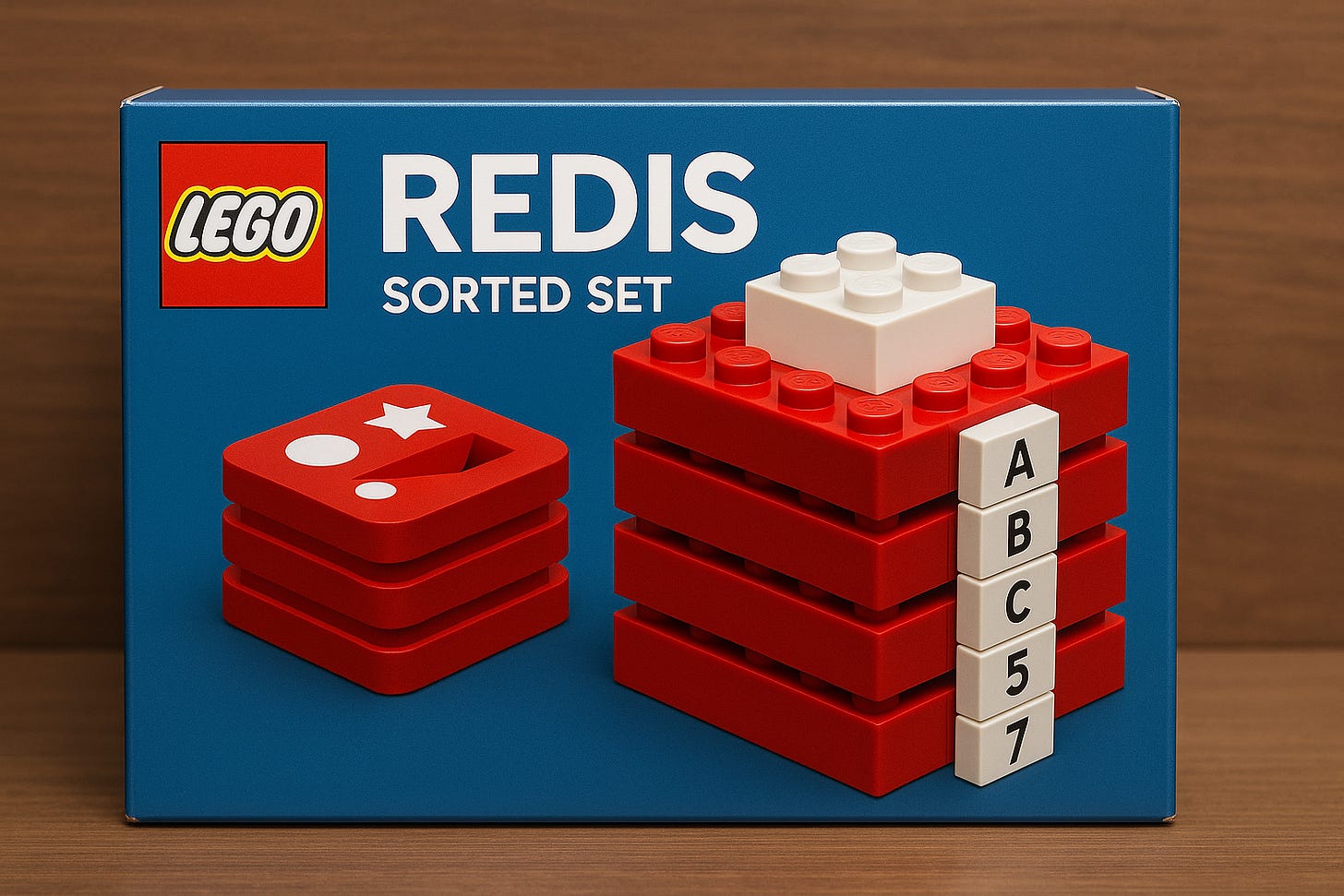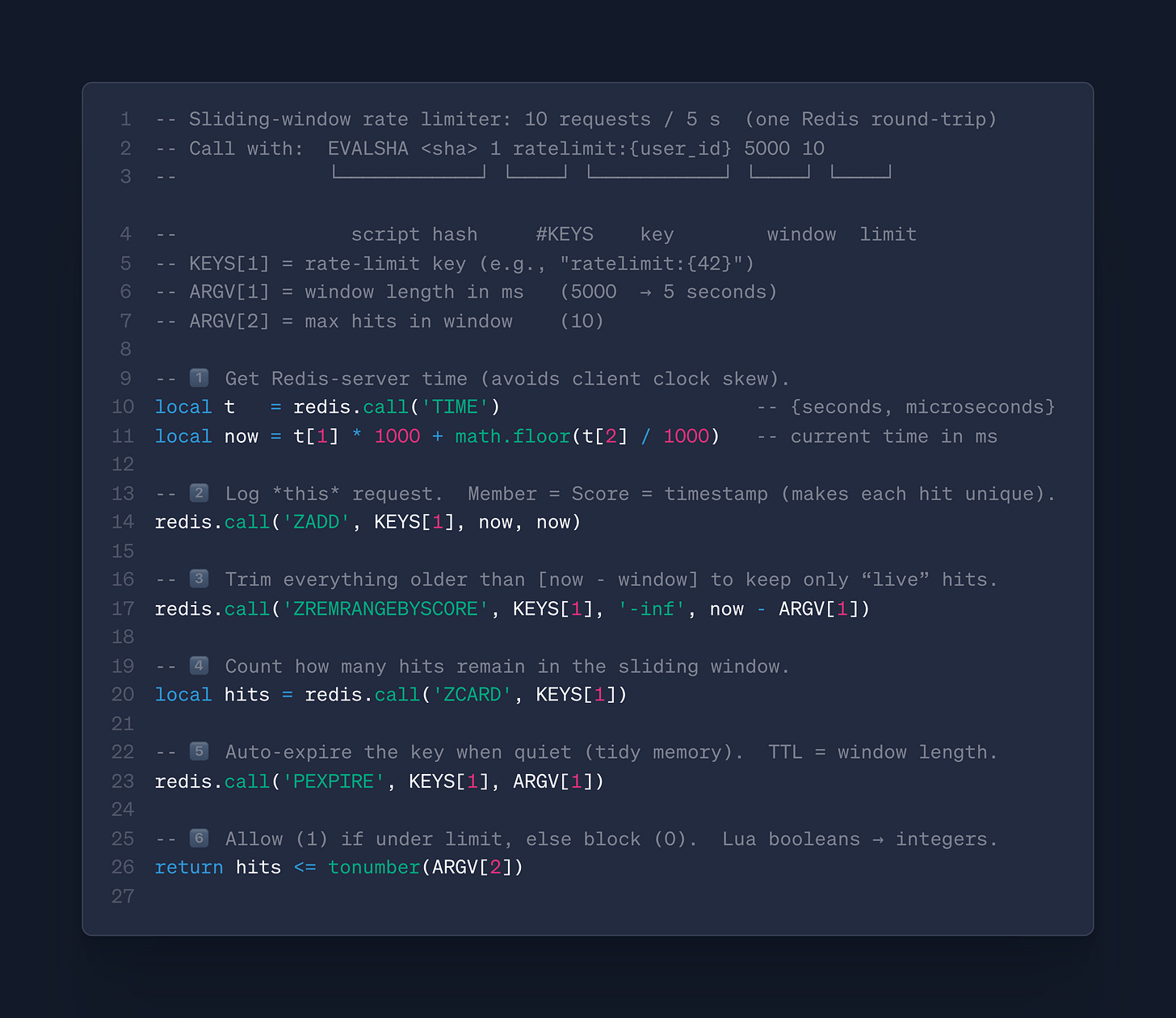Mastering Redis Sorted Sets: Why, When, How to Use Them?
A Practical Guide for Engineers & System-Design Interviews. Learn How to Use Sorted Sets With Me!
To set the scene of why you’d wanna learn about the Redis Sorted Set
.. well besides mentioning it on some system design interview 😅,
imagine these two scenarios every backend engineer dreads:
A single user fires off 200 API calls in two seconds, gliding straight through your “100 req/min” quota because they straddled a window boundary.
A hit-based game launches a weekend tournament and your leaderboard API melts down trying to recompute ranks for 150 K players every time one score changes.
→ Both problems boil down to the same need: keep a running, perfectly ordered view of events while millions of clients hammer your service concurrently.
That’s the precise gap Redis Sorted Sets fill:
In short, Sorted Sets marry uniqueness with always-accurate ordering - no external index, no extra bookkeeping, just one key that scales into the tens of millions.
Enter Redis Sorted Sets
A Sorted Set (ZSET) marries the uniqueness of a set with the order of a list. Every member carries a score (a 64-bit float).
Redis orders the collection by that score and falls back to lexicographic ordering on ties.
Under the hood 👀, each ZSET is:
Hash table → O(1) ZSCORE / ZREM by key.
Skip list → O(logN) ZADD, ZRANK, ZRANGE, etc.
Because skip lists don’t rebalance like B-trees, inserts stay predictably logarithmic - O(logN), even for strictly increasing scores.
Expect roughly 5–6× the memory of a plain list for the same payload . That’s the tax you pay for ordered-index magic.
A Sorted Set trades ~100 B per element (Hash entry ≈ 32 B, Skip-list node ≈ 54 B, SDS string ≈ 32 B) for instant, always-correct ordering.
For leaderboards, rate-limit logs, delay queues, and trending feeds this cost is usually dwarfed by the benefit of answering queries in a singleO(log N)hop—no external index, no SQLORDER BY, no cache-miss gymnastics. 🔥
Where Sorted Sets Shine in Production
If you can attach a number to an event and you care about its order, a ZSET is your Swiss‑army knife!
Let’s explore some places, where a ZSET fits nicely! I actually got the idea of writing this blog-post from the first one 🫣
1. Sliding‑Window Rate Limiting
The need: Stop one user from smothering your API without blocking everyone else. Or more technically: a quota like “10 requests per 5 sec” needs to be enforced with millisecond accuracy, no race conditions, and sub-millisecond latency—even under heavy burst traffic.

How it works:
the command 👇 adds the request timestamp as both score and member)
ZADD key now nowsweep the window (the command 👇 guarantees anything older than the sliding window (for example: 5 000 ms) is evicted, so the set’s size is exactly “requests in the last X seconds.”
ZREMRANGEBYSCORE key -inf now‑windowcount (the command 👇 instantly returns how many hits remain)
ZCARD key (or ZCOUNT .. <min><max>)Why a Sorted Set? The score is the clock, so every request auto‑slides forward.
No per‑user counters, no cron: one atomic script and you’re done. (sharing the code below 👇
)→ for more on rate limiting & the different algos and real-world implications, read this:
Rate Limiting: Concepts, Algorithms, and Real-World Use Cases
Once again, with another recap from what I read around rate limiters from the ByteByteGo Newsletter book. At the end of the book, I will share all my notes on each chapter, so stay subscribed for that soon! 🔥
2. Real‑Time Leaderboards
Games, hackathons, fitness apps – any place where rank sells more excitement than the raw score itself.
So, why SS here? 👉 To keep tens of thousands of players ranked in < 50 ms so the scoreboard feels alive.
to bump the score of a player on the leaderboard:
ZINCRBY leaderboard 175 \"player:42\"
top‑3 in ≈ O(log N):
ZREVRANGE leaderboard 0 2 WITHSCORES → top‑3 in ≈ O(log N).Why a Sorted Set? Scores are updated in O(log N), reads are slices (top‑N) that never scan the full list. It’s a live index that costs almost nothing to maintain.
3. Priority Queues & Delayed Jobs
Why here? To pop the next job exactly when it’s due, or in strict priority order.
schedule a job by Unix‑ms ETA
ZADD queue 1715366400000 \"job:123\"grab the first ready job.
ZRANGEBYSCORE queue -inf now LIMIT 0 1 Why a Sorted Set? The lowest score naturally bubbles to the head, so one read tells you what’s executable and its rank in line.
4. Social Feeds & Trending Topics
The need: Show every user a fresh, relevance‑weighted feed without re‑ranking the world.
Store post IDs scored by timestamp + engagement weight.
their first 50 posts are already ordered by hotness 🥵 :
ZREVRANGE feed 0 49 Why a Sorted Set? It’s a ready‑made "ORDER BY timestamp DESC, likes DESC" index that updates itself as new posts roll in.
5. Rolling Time‑Series Aggregates
Keep only the last N seconds of events and periodically roll‑up to coarser buckets.
Insert each tick –
ZADD ticks now valueEvery minute:
ZPOPMIN ticksuntilZCARDsays era‑done, aggregate and re‑insert into a minute‑level ZSET.
Why a Sorted Set? The oldest data is always in ZRANGE 0 0, so pruning or harvesting is just a few O(log N) pops—no table scans.
A 12-line Lua rate-limiter
As you can see, a lot can be done with just a few commands, so here a 12-line Lua script that implements a rate-limiter:
… then to use it in your app, simply do:
👇 To sum-up what it does:
The script performs the entire log-sweep-count decision atomically inside Redis, so even burst traffic sees a flawless 10-requests-per-5-seconds limit - all in a single network round-trip.
Now, you’ve got a production-ready sliding-window rate-limiter.. with millisecond accuracy! 🤘
Helpful References 🔗
If you wanna dive even deeper on the topic of sorted sets, here are a bunch of resources while making this blog-post:
Recap / tl&dr & 👋
Today I re-read what I summarized for rate-limiters and the use of sortedSets popped up and I was like.. hm, I haven’t actually gone deeper into the topic, so why don’t I do it now 😅
Hence the result is this blog-post. I hope you liked it, learned or refreshed your mind on some stuff around Redis Sorted Sets & where we can use them. 🤘
If you want more blog-articles like this one, on system design and computer science topics, subscribe! I’m back to posting weekly, so much more to come! 🔜
👉 follow me on LinkedIn for more short-form content with interesting nit-picks & quick-knowledge boosts!
have a productive week folks 🚀







